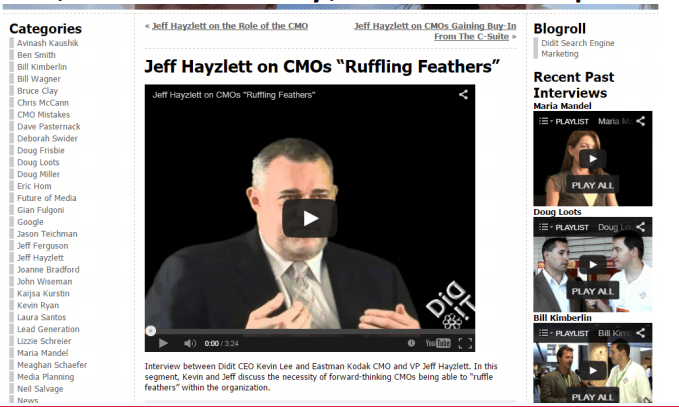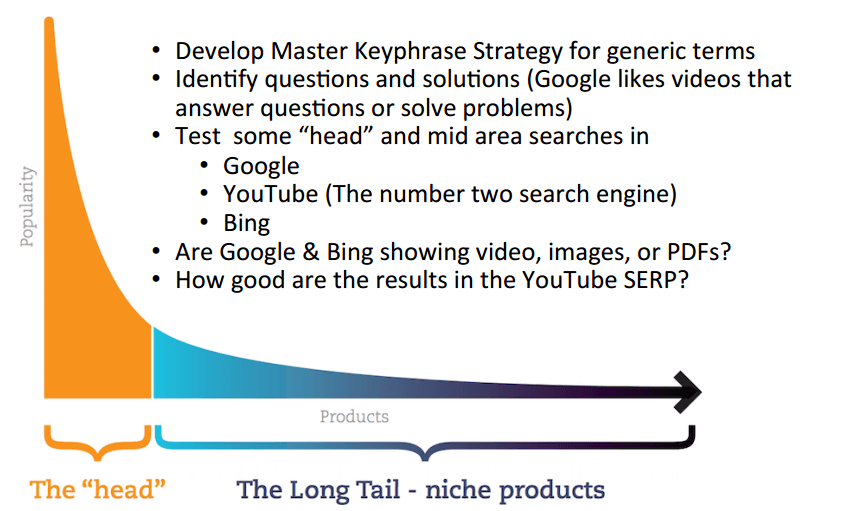In a recent webinar sponsored by Act-On, Thorin McGee, Editor in Chief of Target Marketing Magazine sat down with search engine marketing guru Kevin Lee to talk about how marketers can improve SEO for alternative types of content. That includes video, infographics, images, PDFs, and more. In this five-part blog series, you’ll get expert insights and best practices for developing the right types of content for your brand and making sure they get discovered by your target audiences. Part one sets up the context and key points of alternative SEO. In part two, Kevin covers best practices for optimizing video for SEO.
 KEVIN LEE: So we’ll start with video, because a lot of the best practices in video SEO apply to the others as well, as I mentioned earlier. But also, look at the sheer volume of traffic coming through YouTube. It’s the second largest search engine in the world. Google is number one, YouTube is number two, which is of course owned by Google, and that doesn’t even count situations where a video shows up in a traditional search engine results page. People search within YouTube as well. So YouTube is an extremely heavily trafficked site. It’s a huge opportunity within search. But it also serves the role of just being a great place to have content
KEVIN LEE: So we’ll start with video, because a lot of the best practices in video SEO apply to the others as well, as I mentioned earlier. But also, look at the sheer volume of traffic coming through YouTube. It’s the second largest search engine in the world. Google is number one, YouTube is number two, which is of course owned by Google, and that doesn’t even count situations where a video shows up in a traditional search engine results page. People search within YouTube as well. So YouTube is an extremely heavily trafficked site. It’s a huge opportunity within search. But it also serves the role of just being a great place to have content
There’s an entirely new group of celebrities who are YouTube-only celebrities. They’ve built their credibility and their entire persona around just having really great content on YouTube.
Start by Understanding Your Audience
So now we get to our various Ws, starting with Who. If you put the audience first, it’s a lot easier for you to decide what to create. And part of putting the audience first is to think like a Google or Bing engineer. Because for Google and Bing engineers, almost everything they do is about making sure that the user experience is the best it can possibly be on their search engine.
So because Google and Bing are constantly tweaking their algorithms, putting the audience first, making sure that they watch all of the various signals they have at their disposal. To determine what’s working and what’s not working, you need to think like them. And think about all the feedback signals that Google or Bing might use in addition to links, which have been around ever since Larry and Sergey came up with the concept of PageRank.
So links are votes, and that’s great. More links are better than less links. But increasingly the search engines have had to add additional layers into their ranking algorithms just to validate what the links are telling them, as well as potentially countermanding what the links are telling them if there’s not additional evidence.
Because each of the major search engines, at least in the United States, has its own browser, they actually can look within toolbars in those browsers, or they can look at the browser data itself, or they can look at people navigating back from a search engine results page. So for example if your bounce rate is very high on a page, that’s probably going to be a negative ranking factor. It means you didn’t engage your user.
 Some marketing teams like to think about their various target constituencies as personas, as well as layering on demographics and psychographics. And if you already think about personas, demographics, and psychographics, continue to think that way specifically from the perspective of the kinds of content they would enjoy, and the kinds of content they would consume, as well as the kinds of content they would look for, regarding video in particular for this first section.
Some marketing teams like to think about their various target constituencies as personas, as well as layering on demographics and psychographics. And if you already think about personas, demographics, and psychographics, continue to think that way specifically from the perspective of the kinds of content they would enjoy, and the kinds of content they would consume, as well as the kinds of content they would look for, regarding video in particular for this first section.
A lot of search marketers really focus a lot on keywords. But keywords don’t often tell you that much about the audience. Different audience types could be using the same keyword. And so when you’re just thinking purely keyword centric, you’re not necessarily fully defining all the subcategories of visitors to your site that you might want to create content for. Keywords don’t always line up with audience. Plus you may have different audiences to consider.
- Prospects
- Customers
- Distributors
- Employees
- Press
- Investors
But depending on your individual businesses, you may have very different groups or subcategories of groups even before you get into actually trying to define personas. These are just simple ways of structurally bucketing your target audience into categories that might want video content, textual content, white papers, PDFs, infographics, whatever. Not every business has every one of these categories, and some businesses have more than these categories.
How Video Appears in Search Results
 When you think about the search engine results page, increasingly they become not-text. So here we have an example where, because it’s such a very specific query and video answers that query so well, Google enlarged the thumbnail and actually put a YouTube video front and center in how to tie a tie.
When you think about the search engine results page, increasingly they become not-text. So here we have an example where, because it’s such a very specific query and video answers that query so well, Google enlarged the thumbnail and actually put a YouTube video front and center in how to tie a tie.
Now I don’t know who created the how to tie a tie video. I didn’t bother to go and view it. But certainly it’d be a great thing for a menswear retailer to do. It’d be a great thing for a tie manufacturer to do. And whoever actually created this particular “how to tie a tie” video probably sees a fair amount of traffic, because it’s number one and it’s huge.
 But when you look at other queries, like a painting-related query, you can see that videos are still highlighted within the search results. And again your eye would jump down to that third search result pretty handily. So think about the search engine results page not as purely textual.
But when you look at other queries, like a painting-related query, you can see that videos are still highlighted within the search results. And again your eye would jump down to that third search result pretty handily. So think about the search engine results page not as purely textual.
Obviously YouTube is the 800 pound gorilla in the video world. But there are other platforms where your video can exist as well. Some of them are not as appropriate from an SEO perspective because they tend to be closed systems, like the social platforms such as Facebook and Vine. Those videos that exist within there don’t tend to rank in regular searches. They may rank within searches internal to those particular platforms, but they don’t tend to rank externally. But if you’re already created the content and it makes sense to reuse it or re-platform it in another place, certainly consider doing that.
There are also different expectations of production quality for different ones of these platforms. If you surf through and look at what you find on these platforms beyond YouTube, you’ll find a certain consistency of video production quality in some of them, and in particular like Veoh, but somewhat in Vimeo as well, in comparison to social platforms where a lot of stuff is shot on smartphones and production quality isn’t quite as high. Flickr hasn’t been emphasizing video as much recently, but again it’s worth taking a look at to see if it fits within your strategy.
In the case of Vimeo, they also have an embeddable tool similar to YouTube. On Facebook there’s not a lot of direct SEO value, but if you think that something has viral potential you can certainly try to get it out there on Facebook and see if you get decent organic sharing, or you can of course pay to amplify that with some of the ad platform elements of Facebook.
Setting Videos Free
Don’t think about the videos living exclusively in YouTube itself. Take those same videos and embed them into your blog platforms. One of the main reasons you’d want to do that is you can add your own commentary to the video, which can be very text heavy. So Google still knows that the blog page that has an embedded YouTube video or even a non-YouTube embedded video, Google still understands that that’s video content and as does Bing. And they’re all pretty indifferent really between which source the video came from that’s embedded on the blog. So if you’re weighing one platform versus another, you’ll have to look at the pros and cons of embedding video from one source versus another source into your page.
But the most important thing about it is it gives you additional bites of the apple. Meaning that now that video exists within YouTube and it may rank well within YouTube, but because you’ve added additional commentary or maybe taken a partial or full transcription of the video and included it along with your video, that is essentially considered separate content from your video existing on YouTube. And so you might end up ranking for the same search with your blog post.
Or you could use that same video and in some cases it may be relevant to an article that you’re getting published somewhere as a guest blogger or guest contributor. So again that video serves extra double duty or triple duty or quadruple duty as it continues to get utilized across the ecosystem. You don’t always need to use the exact same clip either. You can shorten the clip that you’re going to be using within your blog and increase the utilization rate of your video.
Creating Snackable Content
So give yourself as many bites of the apple as possible. Slice it up, post it and embed it, promote different versions. So you can see here that two of my interview snippets of Jeffrey Hayzlett, former CMO of Kodak (and he was CMO of Kodak when I did the interviews), rank for this particular query, which is of course extremely specific. But the point I was trying to make is that for very specific queries, which a lot of people do, you have the chance of ranking more than once.
 Because you’re slicing and dicing your video into smaller bite-sized pieces. That’s a huge benefit from a pure SEO perspective, but it also meets the audience’s need. Because depending on your target audience and their personas, some of those are going to have a mild case or severe case of ADD with regards to distractibility as they consume your video content.
Because you’re slicing and dicing your video into smaller bite-sized pieces. That’s a huge benefit from a pure SEO perspective, but it also meets the audience’s need. Because depending on your target audience and their personas, some of those are going to have a mild case or severe case of ADD with regards to distractibility as they consume your video content.
 So they don’t want to see a long-form video. Some of them are just going to want snackable video. Take some of your video content and make it snack-sized, even if you haven’t really thought of doing that before. You may even be able to go back to archival video that you shot from before, corporate video or interview video, and just repurpose it by slicing it up, embedding it in a blog post, or re-uploading it into YouTube or one of the other platforms. It just gives you an opportunity to be more focused in the naming of that video, which we’ll get into a little bit later, because as you slice a video into shorter segments, it’s more specific.
So they don’t want to see a long-form video. Some of them are just going to want snackable video. Take some of your video content and make it snack-sized, even if you haven’t really thought of doing that before. You may even be able to go back to archival video that you shot from before, corporate video or interview video, and just repurpose it by slicing it up, embedding it in a blog post, or re-uploading it into YouTube or one of the other platforms. It just gives you an opportunity to be more focused in the naming of that video, which we’ll get into a little bit later, because as you slice a video into shorter segments, it’s more specific.
So where will a video rank highest? Where do you put your effort? Where do you put your energy? Do you try to get it to rank within a magazine or an industry blog that has great authority already, which is this concept of the fact that content on a specific domain is more likely to rank than the same content on a different domain. If you’ve got a new site or you’re new to SEO, and your site doesn’t have a lot of authority, having the videos exist on your site is probably a less optimal strategy, even though technically you’re getting the traffic to your website.
The Heads and Tails of Keywords
If you should succeed, you might be better off having that video live somewhere else as its primary home. Because you just want to get that video seen. And just because you would prefer it to be seen on your website doesn’t mean it’s the best place to have as your primary home for the video.
You also have to use keyword data to understand the topics that you’ll be creating video from. So there’s what we call the head and the long tail of keywords. In this case for this illustration it was around products. It can be around services as well. It can be around informational content or educational content, as well as content about products
 Once you’ve got your keyword lists and you’ve thought about that, obviously you’d love to have your videos rank for what we call head keywords or head keyword phrases or key phrases. But the reality is, if you’re new to doing video SEO, your likelihood of success is not that high. So figure out how to turn the keywords into topics and then try to think about the different ways of covering the topic:
Once you’ve got your keyword lists and you’ve thought about that, obviously you’d love to have your videos rank for what we call head keywords or head keyword phrases or key phrases. But the reality is, if you’re new to doing video SEO, your likelihood of success is not that high. So figure out how to turn the keywords into topics and then try to think about the different ways of covering the topic:
- Can you tell a story?
- Can someone else tell a story?
- Could there be an argument?
- Is it a “hot topic”?
- Is it timeless content or timely content?
You have to really think about starting to fill in your editorial calendar with this kind of information.
You also want to think about where does your video focus from the perspective of where your target audience is in their decision cycle around your product or service. Because you could be creating video which is really useful during the early stages of education on a product or service, or you can actually get down into doing a comparison between your product or service and a competitor, and actually illustrating the usage situations where your product or service is superior.
Who Should Create the Video?
Once you decide what you want to cover, you need to decide who should create the video. You have a tremendous amount of choices here, including:
- In-house marketing teams
- Digital agencies
- Traditional agencies or PR firms
- Customers (perhaps through a contest)
- Distributors
- Freelance video talent
Customer-created content seems like it’s a real inexpensive way to go, but it’s actually pretty hard to get customers to create video content that fits your marketing needs perfectly. That’s not to say that it doesn’t make sense to do. Some organizations have done a great job creating a large enough contest around this to create some amazing video content.
 I think the one that comes to mind off the top of my head was Doritos who actually ran an ad creation contest for an ad they would run in the Super Bowl. Obviously a lot of people jumped at the idea. So think about all these touch points that you have within your own organization and within your marketing ecosystem. And think about who should be the creator of the video and how can you collaborate with some of these folks to create better video.
I think the one that comes to mind off the top of my head was Doritos who actually ran an ad creation contest for an ad they would run in the Super Bowl. Obviously a lot of people jumped at the idea. So think about all these touch points that you have within your own organization and within your marketing ecosystem. And think about who should be the creator of the video and how can you collaborate with some of these folks to create better video.
Then you have to decide who’s in the video. If there’s going to be a talking head, who’s that talking head going to be? Is it going to be a conversational interview or is it going to be a different style of video? There are lots of options out there for you.
You can go out with moderately good video equipment to your industry trade shows and do sort of the on-the-street interviews with influencers that you happen to either cross paths with or you’ve pre-scheduled interviews with at conferences. And that makes for great content. It certainly tends to be on the less expensive side, because you just have to bring your camera person with you.
And the only comment I’d make for all of these actually is audio makes a huge difference. Some video equipment will allow for wireless microphones. And if you’re going to be investing a lot into video SEO, invest a little bit into some equipment that allows for microphones to be used either wired or wirelessly. Because having good audio on your video dramatically increases the likelihood that people will sit through it.
 Stay tuned for part three of this series, where you’ll get an in-depth look at creating the right content for your brand. Be sure to watch the webinar to get the whole story. And if you want more information on optimizing content for search, check out this eBook: How to Make Any Content SEO-Friendly.
Stay tuned for part three of this series, where you’ll get an in-depth look at creating the right content for your brand. Be sure to watch the webinar to get the whole story. And if you want more information on optimizing content for search, check out this eBook: How to Make Any Content SEO-Friendly.
